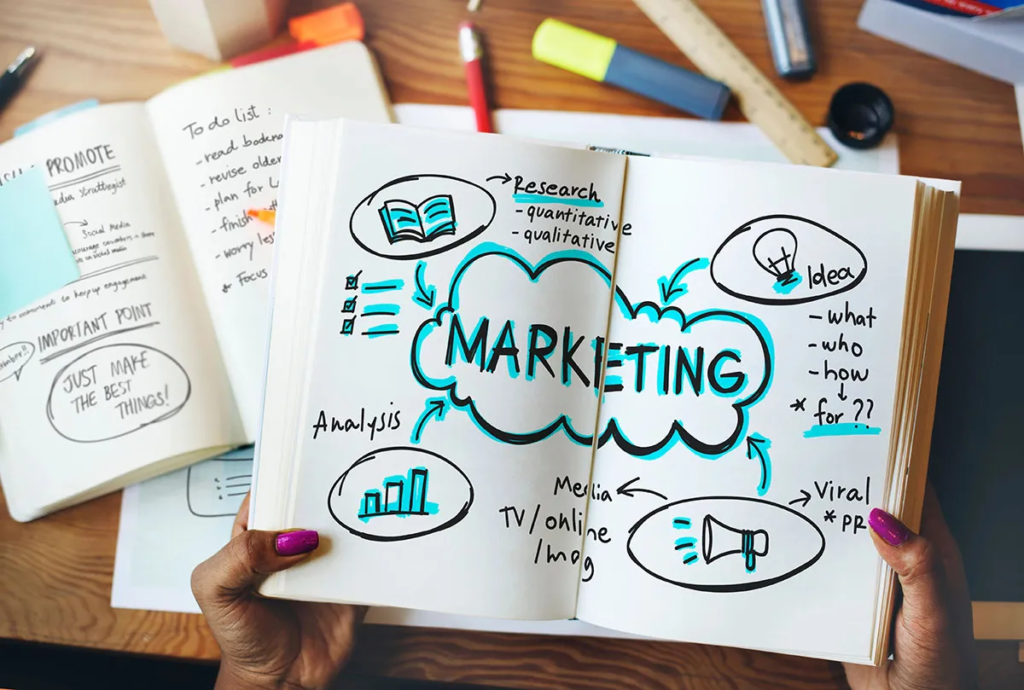
1. Introduction to Marketing
What Is Marketing?
Marketing is the art and science of delivering the right message to the right audience at the right time. It involves identifying consumer needs, creating valuable content or products, and communicating effectively to drive engagement, conversion, and customer loyalty. Whether it’s building a memorable brand, launching a viral campaign, or crafting a killer landing page — marketing is the force that fuels business growth.
Why Marketing Is Essential in Every Business
In 2025, marketing is not optional — it’s the lifeblood of any organization. Companies that fail to market themselves effectively will lose visibility, customers, and ultimately, relevance. Strategic marketing creates awareness, builds trust, and nurtures relationships — all of which are necessary for long-term success.
The Evolution of Marketing Over Time
From billboard ads to TikTok reels, marketing has come a long way:
- 1950s–70s: Mass media marketing (TV, radio, newspapers)
- 1980s–90s: Direct marketing & telemarketing
- 2000s: Rise of digital marketing (websites, email, PPC)
- 2010s: Social media revolution
- 2020s–2025: Personalization, AI, voice search, community-driven content
Key Marketing Objectives in 2025
- Build brand trust and credibility
- Generate qualified leads
- Convert leads into paying customers
- Increase customer lifetime value
- Drive sustainable growth with ethical, inclusive marketing
2. Types of Marketing (With Examples)
Marketing is no longer one-size-fits-all. Here’s a look at the most important types in 2025:
Traditional Marketing
- Examples: TV commercials, radio ads, flyers, print magazines
- Strengths: Mass reach, brand awareness
- Weaknesses: Expensive, hard to measure ROI
Digital Marketing
- Examples: SEO, PPC, content, email, social media
- Strengths: Measurable, scalable, cost-effective
- Weaknesses: Requires ongoing learning and adaptation
Inbound vs Outbound Marketing
- Inbound: Pull strategy → Attract leads through valuable content (blogs, SEO, social)
- Outbound: Push strategy → Direct outreach (cold calls, TV ads)
Influencer Marketing
Partnering with influencers to promote products organically via their audience.
Guerrilla Marketing
Creative, often low-cost campaigns that go viral due to shock, humor, or innovation.
Cause-Based & Ethical Marketing
Aligning your brand with a social cause (sustainability, DEI, charity) to build loyalty.
3. The 4Ps and 7Ps of Marketing Mix
The Marketing Mix helps structure any campaign:
The 4Ps:
- Product – What are you offering, and why should people care?
- Price – What’s the perceived value and pricing model?
- Place – Where and how do customers find you?
- Promotion – How do you spread the word?
The 7Ps (Extended Mix for Service-Based Businesses):
- People – Your team and customer service approach
- Process – Customer journey and operations
- Physical Evidence – Tangible proof (e.g., reviews, testimonials, packaging)
Example: A SaaS company might offer a freemium product (Product), priced at $9.99/month (Price), via its website (Place), promoted through email (Promotion), supported by trained reps (People), with an automated onboarding sequence (Process), and Google reviews (Physical Evidence).
4. Marketing Strategy: How to Build One from Scratch
1. Understand Your Market
Use surveys, competitor research, and tools like Google Trends or Statista.
2. Define Customer Personas
- Name: Freelancer Felicia
- Pain Point: Wants more leads, no budget for ads
- Ideal Offer: Free lead magnet, email nurturing
3. Set SMART Goals
- Specific
- Measurable
- Achievable
- Relevant
- Time-bound
4. Choose Your Channels
SEO, email, paid ads, social media — don’t try everything at once. Test and double down on what works.
5. Allocate Budget
Include paid tools, ad spend, creative services, team training.
6. Monitor KPIs
Use tools like Google Analytics, HubSpot, or Hotjar to track conversions, traffic, and engagement.
5. Digital Marketing Deep Dive
Digital marketing is where brands thrive in 2025. Let’s break it down by core areas:
🔍 A. Search Engine Optimization (SEO)
Why SEO Still Matters
SEO drives organic traffic — the kind that converts better, lasts longer, and doesn’t cost per click. In a world of rising ad costs, SEO is your most powerful long-term asset.
Key SEO Pillars
- On-Page SEO:
- Use targeted keywords naturally in titles, meta descriptions, headers, and body text
- Optimize images with alt text
- Use internal linking to keep visitors on-site
- Off-Page SEO:
- Build backlinks from high-authority websites
- Participate in guest blogging, forums, interviews
- Gain mentions on industry platforms
- Technical SEO:
- Fast-loading pages (use tools like PageSpeed Insights)
- Mobile optimization
- XML sitemap and structured data
Top Tools for SEO in 2025
- Ahrefs
- SEMrush
- Surfer SEO
- Google Search Console
- Screaming Frog
Pro Tip: Focus on building topical authority — don’t just rank for one keyword, dominate a whole cluster.
🧠 B. Content Marketing
Why Content Is Still King in 2025
People don’t want ads — they want answers. Content marketing educates, entertains, and builds trust.
Top Content Types
- Blog posts
- Videos (YouTube, Reels, Shorts)
- Webinars & podcasts
- Infographics
- E-books & whitepapers
Content Marketing Strategy
- Identify pain points
- Create content around those problems
- Use SEO to distribute
- Repurpose across platforms
Frameworks That Work
- Pillar & Cluster Model: One core page with multiple supporting blog posts
- AIDA: Attention → Interest → Desire → Action
- Problem-Agitate-Solution (PAS)
Example:
Pillar: “How to Start an Online Store in 2025”
Clusters: SEO for eCommerce, Shopify vs WooCommerce, eCommerce copywriting tips
💌 C. Email Marketing
Why Email Still Converts
Email marketing generates a 36:1 ROI — it’s personal, permission-based, and scalable.
Steps to Build a Successful Email Campaign
- Create a lead magnet (PDF, checklist, quiz)
- Build an opt-in form with a clear CTA
- Segment your list (by interest, behavior, or funnel stage)
- Write compelling, value-first emails
- A/B test subject lines and CTAs
Email Marketing Tools
- Mailchimp
- ConvertKit
- Klaviyo
- HubSpot
- Brevo (formerly Sendinblue)
Best Practices
- Personalize (“Hi Sarah,” not “Dear Customer”)
- Keep it mobile-friendly
- Use clear CTAs
- Automate onboarding and follow-ups
📱 D. Social Media Marketing
Social Media in 2025 Is All About:
- Authentic content
- Bite-sized video
- Creator partnerships
- Community engagement
Platform Breakdown
| Platform | Best For | Pro Tips |
|---|---|---|
| Visual storytelling | Use Reels + Stories | |
| TikTok | Viral content, Gen Z | Short hooks & challenges |
| B2B & thought leadership | Post consistently + engage in comments | |
| YouTube | Evergreen content | SEO-optimize titles & thumbnails |
| Threads/X | Community & trends | Hot takes, quick updates |
How to Win on Social
- Plan with a content calendar
- Use analytics to spot trends
- Repurpose content across platforms
- Collaborate with micro-influencers
6. Marketing Funnels & Conversion Tactics
What Is a Marketing Funnel?
It’s the journey a lead takes from discovering your brand to becoming a loyal customer.
Stages of the Funnel
- Awareness – They find you (via SEO, social, ads)
- Interest – They want to learn more
- Desire – They’re comparing solutions
- Action – They convert (buy, subscribe, etc.)
- Loyalty – They return or refer others
High-Converting Tactics
- Landing Pages: Focused, minimal distractions, clear CTA
- Lead Magnets: Free resources in exchange for emails
- Retargeting Ads: Bring back drop-offs
- Popups & Exit-Intents: Catch leads before they leave
Tool Stack for Funnel Building
- ClickFunnels
- Leadpages
- Unbounce
- HubSpot
- GetResponse
7. Performance & Analytics
Why Data-Driven Marketing Wins
If you’re not tracking performance, you’re guessing. Smart marketers use data to refine, retarget, and outperform competitors.
Key Marketing KPIs
- Traffic (organic, referral, direct)
- Conversion Rate (CRO)
- Customer Acquisition Cost (CAC)
- Lifetime Value (LTV)
- Return on Ad Spend (ROAS)
- Engagement (CTR, bounce rate, time on page)
Marketing Analytics Tools
- Google Analytics 4 (GA4)
- Hotjar (heatmaps, recordings)
- HubSpot CRM
- Tableau or Looker Studio (data visualization)
- Mixpanel (behavior analytics)
8. AI and Automation in Marketing
The Future of Marketing Is Here
AI doesn’t replace marketers — it empowers them.
Top Use Cases for AI in 2025
- Predictive customer insights
- Content creation (e.g., ChatGPT, Jasper AI)
- Email personalization
- Smart chatbots & customer support
- Social media scheduling & engagement
- Dynamic pricing & recommendation engines
Best AI Tools for Marketers
- Jasper (copywriting)
- Copy.ai (landing pages)
- SurferSEO (content SEO)
- ManyChat (chatbots)
- Zapier (workflow automation)
Ethics Tip: Always disclose AI-generated content and avoid manipulative tactics.
9. Marketing Trends to Watch in 2025
Emerging Trends
- Zero-Click Content: Users get answers without clicking (optimize featured snippets)
- Voice & Visual Search: Optimize for Siri, Alexa, Google Lens
- Privacy-First Marketing: Embrace cookieless data and first-party strategies
- Hyper-Personalization: AI-based segmentation and dynamic content
- Community-Led Growth: Build loyal user communities (Discord, Slack, LinkedIn Groups)
Bonus Trend: Interactive content (quizzes, calculators, live polls) increases time on page and conversion.
10. Case Studies: Real-World Marketing That Worked
1. Duolingo’s TikTok Strategy
- Used memes + humor
- Humanized their brand mascot
- Gained millions of followers organically
2. Nike’s Cause-Based Campaigns
- Leveraged emotional storytelling (e.g., Colin Kaepernick campaign)
- Strengthened brand loyalty with Gen Z
3. Shopify’s Content Hub
- Created a huge blog + academy + podcasts
- Dominates SEO for eCommerce terms
11. Common Marketing Mistakes to Avoid
- Ignoring SEO basics
- Not defining your audience clearly
- Over-promoting on social media
- Not tracking results
- Chasing trends without strategy
- Poor mobile experience
- Inconsistent branding
12. Tools & Resources for Marketers
Must-Have Tools
| Function | Tools |
|---|---|
| SEO | Ahrefs, Surfer, Screaming Frog |
| Mailchimp, Klaviyo, ConvertKit | |
| Content | Grammarly, Jasper, Notion |
| Analytics | GA4, Hotjar, HubSpot |
| Project Mgmt | Trello, Asana, ClickUp |
| Automation | Zapier, Make, ManyChat |
Recommended Books
- “Contagious” by Jonah Berger
- “Building a StoryBrand” by Donald Miller
- “Made to Stick” by Chip & Dan Heath
Podcasts & YouTube Channels
- Marketing School (Neil Patel & Eric Siu)
- The GaryVee Audio Experience
- HubSpot YouTube Channel
- Ahrefs & Moz tutorials
13. Final Thoughts + Pro Marketing Tips
- Focus on value before promotion
- Don’t be everywhere — be where your audience is
- Test constantly, measure religiously
- Stay updated: marketing changes fast
- Invest in building your brand, not just ads
Conclusion
Marketing in 2025 is smarter, faster, and more human than ever before. Whether you’re a solo founder or part of a global brand, the key is to stay relevant, stay valuable, and keep evolving.
💡 Ready to level up your marketing?
Download our free Marketing Strategy Workbook, subscribe to our newsletter, and share this guide with your team.
